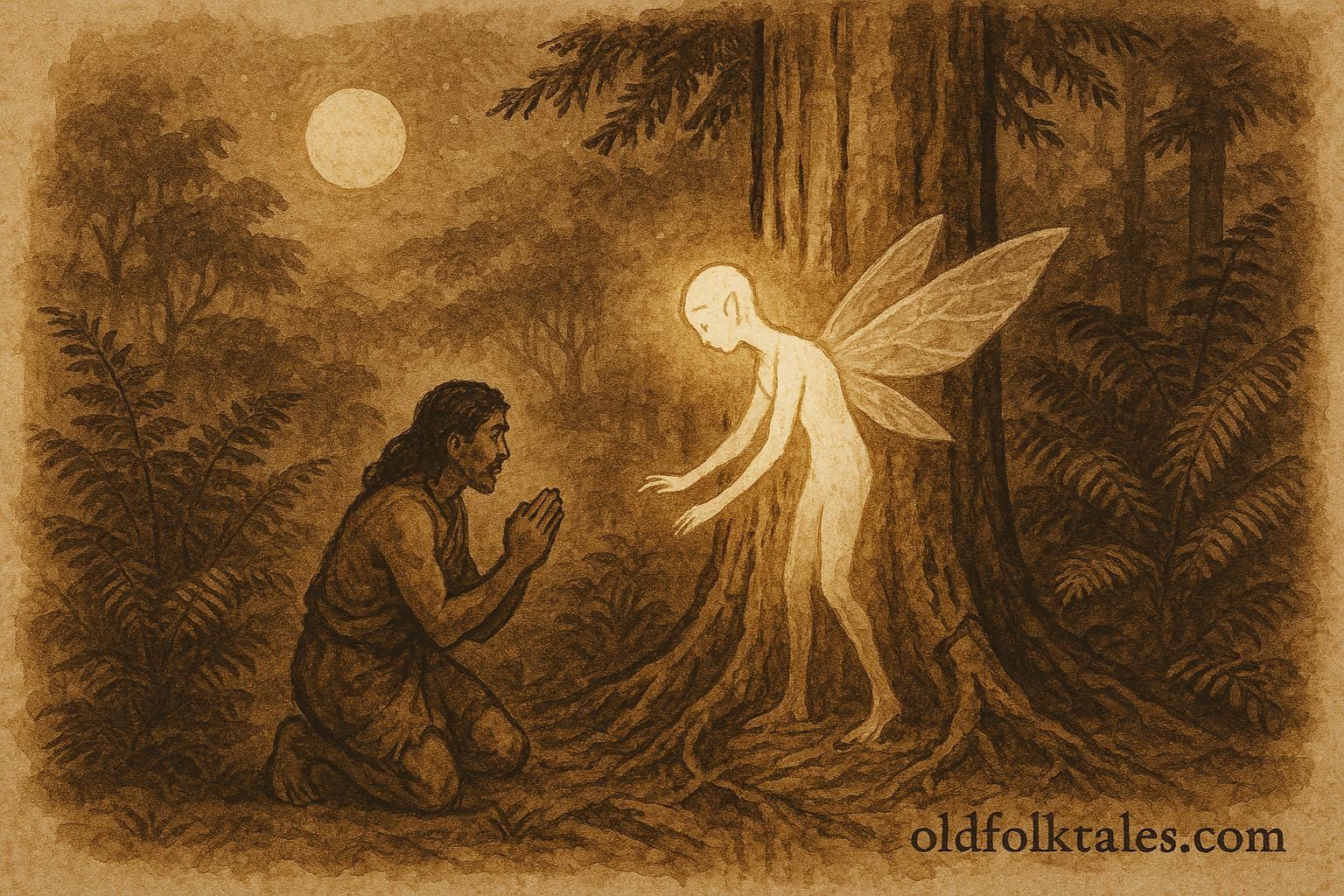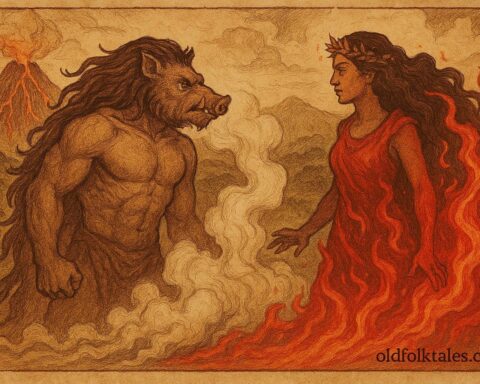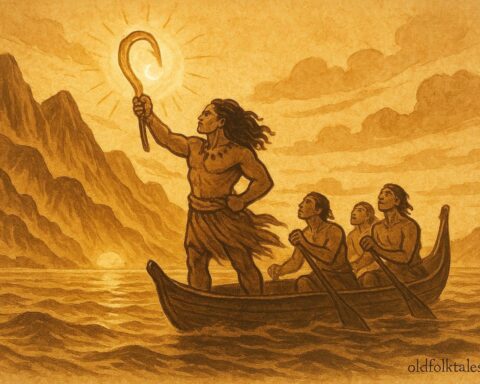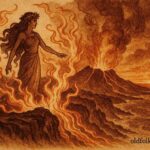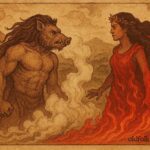In the ancient forests of Aotearoa, where the sunlight filtered through thick ferns and birds sang the names of gods, there lived a young man named Rata. He was the son of a great chief who had once ruled with courage and wisdom. But when Rata’s father was slain by enemies from across the sea, grief settled over their people like a dark cloud.
Rata was still young, but the fire of vengeance burned fiercely in his heart. “I will build a great canoe,” he declared, “and sail across the waters to bring justice for my father’s death.” His people admired his bravery, for his father’s bloodline was noble and his heart strong. Yet in his zeal, he sometimes forgot the ancient laws that bound humankind to the spirits of the natural world.
To the Māori, every part of creation lived under the guardianship of atua, divine beings, and of these, none was more sacred than Tāne-mahuta, god of the forest. Tāne’s trees were his children, his roots the veins of the earth. Before cutting a single tree, one must always offer karakia, prayers of thanks and permission. These rituals reminded people that to take from the earth was not an act of power, but of partnership.
But Rata, driven by sorrow and purpose, believed that words could not shape wood or avenge a father. “The gods will understand my heart,” he thought. “I have no time for ceremony.” And so, one dawn, he entered the deep green forest carrying his stone axe.
The forest loomed vast and ancient. Shafts of sunlight danced across moss-covered trunks, and the air smelled of damp soil and fern. The songs of tui and bellbirds echoed faintly, as if they too watched and waited. Rata searched until he found a great totara tree, tall, straight, and strong enough to become the body of his canoe. Without a word of thanks or prayer, he struck the first blow.
The sound of the axe rang through the grove like thunder. Chips of sacred wood scattered across the ground as Rata worked tirelessly from sunrise to sunset. When the great tree finally groaned and fell, its crash echoed down the valley. The birds flew away in frightened bursts. Sweat streamed down Rata’s face, but he smiled. “Tomorrow, I will begin shaping the canoe,” he said.
But when dawn broke and Rata returned to his work, his heart froze, for the fallen tree was standing upright once more, as though it had never been touched. Around it, the chips and branches were neatly restored, the earth beneath untouched. The forest was still and silent, the air thick with something unseen and powerful.
Thinking it a dream, Rata raised his axe again and worked until his muscles burned and his hands bled. Once again, the tree fell. Once again, he left it for the night.
And when he returned at sunrise, the tree had risen again.
Fury filled him. He struck the ground and shouted into the stillness, “Who defies me? What power mocks my labor?” The wind whispered through the branches but gave no answer. Determined to uncover the mystery, Rata hid himself among the ferns and waited through the long night.
As the moon rose high and bathed the forest in silver, the air stirred. From the shadows came tiny shapes, the Hākuturi, the forest spirits who served Tāne-mahuta. They glimmered like fireflies and moved like the wind, their voices soft as birdsong. Hundreds of them danced through the grove, carrying fallen chips of wood and singing ancient chants. Their song wove through the trees like threads of light, and under their hands, the scattered pieces of the tree lifted and joined once more. Slowly, the mighty totara stood whole again, strong and living.
Rata gasped. The Hākuturi turned toward him, their eyes glowing with the light of the moon. One, taller than the rest, spoke in a voice like rustling leaves.
“Rata, son of noble blood, why do you strike the children of Tāne without prayer or thanks?”
Rata fell to his knees. “I sought only to build a canoe to avenge my father,” he said. “I meant no harm to the forest.”
The spirit shook its head. “Intent does not erase disrespect. The forest is sacred. To take from it without asking is to wound the heart of Tāne himself.”
Shame filled Rata’s heart. “I see my error,” he whispered. “Teach me the proper way, and I will honor it. Forgive me for my arrogance.”
The Hākuturi smiled, and their light brightened the grove. “Your heart has learned humility. Because you have seen and understood, we will aid you.”
That night, under the silver light of the moon, the Hākuturi began their work. Their chants filled the air as they moved around the great tree, shaping and smoothing with hands that glowed like embers. The sound of carving filled the forest, though no tool was seen. Rata watched in wonder as the sacred wood transformed before his eyes into a magnificent waka, long and graceful, its sides carved with spirals and the faces of ancestors.
When dawn came, the canoe lay gleaming beside the riverbank, ready to sail. Rata bowed low before it. “You have blessed me beyond measure,” he said. “This canoe will not be one of vengeance alone, but of honor.”
The voice of the forest whispered through the leaves,
“Go, Rata. Remember what you have learned, that strength without reverence is folly, and all things taken from the world must be given back in gratitude.”
With humility in his heart, Rata set out upon the waters. The canoe glided swiftly, guided not only by his hands, but by the blessings of the forest itself. His journey became legend, not for war or victory, but for the lesson it carried, that every act must honor the balance between humanity and the living world.
Moral Lesson
Rata’s story reminds us that true strength lies in humility. To take from nature without reverence is to forget our place within it. When we act with gratitude and respect for the sacred rhythms of life, even the gods will guide our hands. Harmony, not haste, is the heart of wisdom.
Knowledge Check (Q&A)
- Who was Rata, and what drove him to build a canoe?
He was a Māori warrior seeking to avenge his father’s death across the sea. - Why did the tree Rata felled stand again each morning?
Because he ignored sacred rituals, the forest spirits restored it to teach him respect. - Who were the Hākuturi in the story?
They were divine forest guardians serving Tāne-mahuta, god of the forest. - What lesson did Rata learn from the spirits?
That reverence and humility are essential when taking from nature. - What did the Hākuturi do to help Rata?
They shaped the sacred tree into a beautiful canoe after he repented. - What is the cultural meaning of this Māori folktale?
It teaches the sacred bond between humans and nature, and the moral power of respect.
Source: Adapted from The Maori-Polynesian Comparative Dictionary by Edward Tregear (1891).
Cultural Origin: Māori folktale, Aotearoa (New Zealand).
